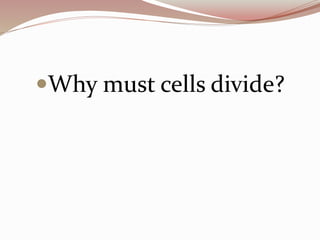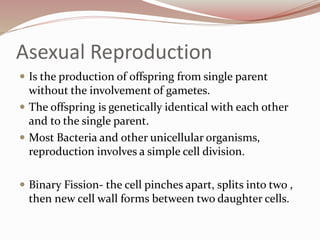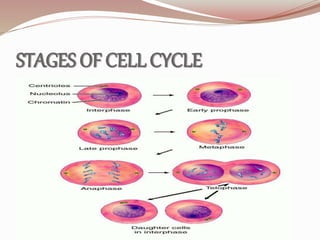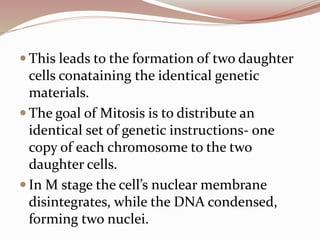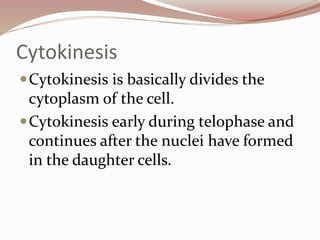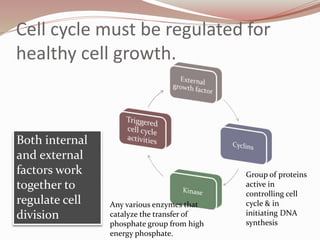Cell DIVISION/cycle
- 1. Cell Cycle
- 2. Learning Objectives Infer the significance of cell division. Differentiate a DNA molecule, a chromosome, and a chromatid. Characterize the phases of the cell cycle and their control points. Describe the major events associated with stages of mitosis. Explain the process of cytokinesis. Describe the role of apoptosis in the life cycle of a cell. Relate cancer as a result of the malfunction of the cell during the cell cycle.
- 3. Values Uphold the importance of cell cycle and reproduction especially in the perpetuation of generation of species. Advocate preservation of life
- 4. Why must cells divide?
- 6. Cell division plays important roles in the lives of organism
- 7. Growth and Development Cell division is associated with growth and development. Humans are products of numerous cellular divisions, as life begins with only a single cell from the fusion of parent’s sex cells.
- 8. How come bacteria and other minute organisms reproduce faster and live in almost everywhere on Earth? Reproduction is common process among life forms to make new organism from one or two parent organism. Sexual Reproduction- involves two specialized cells, called gametes, coming from the parents that will result to a unique offspring.
- 9. Asexual Reproduction Is the production of offspring from single parent without the involvement of gametes. The offspring is genetically identical with each other and to the single parent. Most Bacteria and other unicellular organisms, reproduction involves a simple cell division. Binary Fission- the cell pinches apart, splits into two , then new cell wall forms between two daughter cells.
- 11. Where do cells get the information they need to function? The cell’s genetic material is organized in tightly-coiled structures called chromosomes. A chromosome is simply a long, continuous thread of DNA wounded together by DNA- associated proteins, referred as histones.
- 12. DNA is loosely organized like scattered spaghetti on a plate.
- 13. Chromatin efficiently packages the DNA into small volume and fits inside the nucleus. Chromatin undergoes further condensation, forming the chromosome
- 14. The complex set of macromolecules that contain loose DNA, proteins, and RNA is called chromatin. Chromatin is responsible for packaging the DNA efficiently into smaller volume so that it fits the nucleus of a cell to protect the DNA structure and sequence, to prevent DNA damage, to control gene expression and DNA replication, and to reinforce the DNA molecule to allow mitosis and meiosis
- 15. Chromatid refers to each strand of the duplicated chromosomes. Together they are called sister chromatids, which are held together by centromere – a region of condensed pinched chromosomes. Located at the centromere is a group of proteins called kinetochore, which is attached to the spindle fibers during cell division.
- 16. At the ends of the DNA molecules are structures referred as telomeres that contain repeated nucleotides, which contain genetic information that do not translate into pairs. Their role is to prevent the ends of chromosomes from accidentally attaching to one another and prevent the loss genes.
- 17. Main Idea: Cell have distinct phases fro growth, reproduction, and normal operations. EQ: How do healthy cells decide when to divide?
- 18. THE CELL CYCLE Cells follow definite stages of growth, duplication, and division known collectively as the cell cycle.
- 19. STAGES OF CELL CYCLE
- 21. INTERPHASE Interphase is the growth period in the cell cycle and is divided into three parts
- 22. Gap 1 (G1) Gap 1 is the first part of the cell cycle wherein the cell carries out its normal metabolic functions. During Gap 1 phase , an intestinal cell performs its primary function to absorb nutrients, while a red blood cells shuttles oxygen to the rest of the body. During this phase, cells also increase their size, as their organelles increase in number. Cells have a required size limit.
- 23. Synthesis (S) Synthesis is the second part of cell cycle, which refers to the time that the cell makes a copy of the genetic material in the form of nuclear DNA. During S phase, the cell spends considerable amount of time and energy to make copies of its chromosomes.
- 24. Gap 2 (G2) During this stage, cells continue to carry out their normal functions and also undergo further growth. This stage contain a critical checkpoint before transitioning to the next stage. The cell make sure that everything is in order, including growing to its correct size and duplicating DNA without damage.
- 25. Mitosis (M) Mitosis involves the division of the nucleus and the genetic material. Parts of Mitosis o Prophase o Metaphase o Anaphase o Telophase During M stage, the hereditary materials of parent cell is given to the daughter cells.
- 26. This leads to the formation of two daughter cells conataining the identical genetic materials. The goal of Mitosis is to distribute an identical set of genetic instructions- one copy of each chromosome to the two daughter cells. In M stage the cell’s nuclear membrane disintegrates, while the DNA condensed, forming two nuclei.
- 27. Cytokinesis Cytokinesis is basically divides the cytoplasm of the cell. Cytokinesis early during telophase and continues after the nuclei have formed in the daughter cells.
- 28. Rate of Cell Division Growth rates vary widely in different organism and even in the different tissues within an organism. Common Cell Life Span Cell Type Approximate Life Span Skin Cell 14 days Red Blood Cell 12odays Liver cell 300-500 days Internal lining of intestine 4-5 days Smooth muscles of intestine 16 years
- 29. Some parts of the body where cell divides are rarely believed by scientists to have entered a stage known as gap zero or G0. In this stage, cell are unlikely to divide but still continue to perform normal function. Such cells, like neuron cells and heart muscle cell that are highly differentiated or specialized and that body cannot easily replace, are said to be permanently in G0.
- 30. The Mechanism of Cell Division Mitosis and cytokinesis produce genetically identical daughter cells. How is information passed to new cells during cell division?
- 31. Mitosis Is the division of nucleus into two genetically identical nuclei containing the same full set of DNA. Mitosis occurs in body cells, except the sex cells. Mitosis prepares the cells for cytokinesis. Phases of Mitosis Prophase Metaphase Anaphase telophase
- 32. Prophase: Start of Mitosis Prophase (pro means “before”). During prophase, several distinct events occur. In prophase, the nucleus disppears. Chromatin condenses into chromosomes and the mitotic spindles is formed. Spindle fibers are organized microtubles.
- 33. Metaphase: Chromosomes at the Center Metaphase (meta means “near”, the spindle fibers attached to the kinetochore of sister chromatids facilitates the movement of chromosomes toward the middle of the cell. During metaphase, chromosomes align at the metaphase plate.
- 34. Anaphase: Chromatids to opposites Poles Anaphase ( ana means “up” or “back”), sister chromatids are tightly paired due to the centromere and protein cohesion, which is responsible for holding DNA molecules together in its entire length. In anaphase, chromatids separated toward opposite poles.
- 35. Telophase: reformation of Nuclei Telophase (telo means “end”), the two complete sets of identical chromosomes are now positioned at each pole of the cell, and the reverse of the major events in prophase happen. In telophase, new nuclear envelope forms. Chromosomes unfold back into chromatin, the nucleoli reappear, and the cell continues to elongates.
- 36. Love of Lab Locating the Stages of Mitosis on page 96A.
- 37. Cytokinesis This stage involves splitting of the cytoplasm into two cells and completes the entire cytoplasm divides. Cytokinesis typically starts to occur in late anaphase or telophase. It also differs in plants and animal cell because of some differences in cellular structure.
- 38. In animals cells, cytokinesis starts with the formation of cleavage furrow or trench that is pulled inward by tiny strands of protein actin called microfilaments like a drawstring Slowly membrane begins to pinch roughly in half and close off, forming a separate cell around each nucleus. Daughter cells receive equal portions of parents cell’s plasma content.
- 39. In plants cell the membrane cannot pinch off because of the presence of cell wall. Instead cell plate form midway between the two daughter cells’ nuclei. This Cell plate is made by the golgi apparatus, while vesicles supply the new cells wall material and lipids to form plasma membrane to the cell plate. Cytoplasm is equally divided between both plants and animal cell.
- 40. Cell cycle must be regulated for healthy cell growth. Both internal and external factors work together to regulate cell division Group of proteins active in controlling cell cycle & in initiating DNA synthesis Any various enzymes that catalyze the transfer of phosphate group from high energy phosphate.
- 41. External Factors External factors from outside the cell that are in the form of message from nearby cells or from remote parts of the organism’s body. Physical and Chemical External factor help regulate the cell cycle. Physical signs, such as cell-to-cell contact, exist between cells. Mammalian cells experiments grown in in vitro laboratory steup grow until a single layer covers the entire surface of the culture dish.
- 42. When cell touches another cell, it stops dividing- a phenomenon called contact inhibition. Another study shown cell that shown cell only grow if surface is available and stop dividing when detached from the culture dish – a phenomenon called anchorage dependent. One explanation for this is there are receptors found in neighboring cell binding each other and causing the cell’s cytoplasm to form structures that can block the signal, stopping the continuous division.
- 43. Chemical signals Released by the cell such as growth factors provide instructions for other cells to grow. Growth factor are proteins that stimulates cell division, which have the ability to activate specific genes to trigger cell growth.
- 44. Internal factor Come from inside the cell that include several types of molecules in its cytoplasm. The most well-studied internal factors in eukaryotic cell cycle are kinases and cyclins. Kinase is an enzyme that transfers a phosphate group from one molecule to the target molecules. Cyclins are group of proteins active in controlling cell cycle & in initiating DNA synthesis.
- 45. Apoptosis Orderly programmed cell death t or suicide. Apoptosis is needed by the body to ensure proper cell functioning. Apoptosis occurs in body’s webbed fingers during embryonic period to allow detachment of fingers and thumbs before baby is born.
- 46. What happens to the body when there is uncontrolled cell growth?
- 47. CANCER: Growing Out Of Control Cancer refers to a group of diseases characterized by uncontrolled and abnormal cell division. It occurs when there is a disruption in the cell cycle. Instead of stopping and starting at appropriate points, cancerous cell divide continuously until a disorganized solid mass of cells called tumor is formed.
- 48. Tumors can be categorized as benign or malignant. Benign Tumors are cancer cells that remain clustered together which may be harmless or not and can probably be cured when removed out of the body. Tumors that break away or metastasize are called malignant tumors. Their ability to break away from their present location allows them to be transported to the bloodstream of the lymphatic system to other parts of the body parts to form more tumors.
- 49. Standard cancer treatment option Local surgery radiation Systematic chemotherapy immunotherapy Involves removal of the cancerous body part Involves exposure to X-rays to kill cancer cell and shrink the tumor cells Uses certain drug to kill actively dividing cells Uses substances either from the body or laboratory to improve the body’s defense to fight cancer



